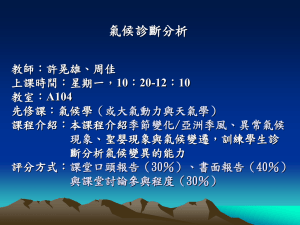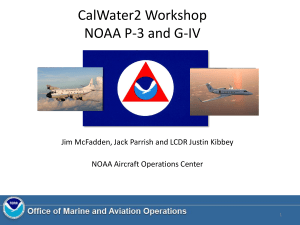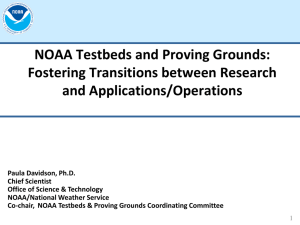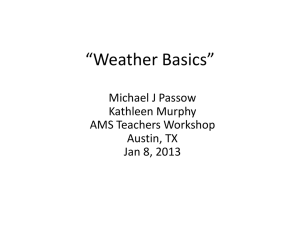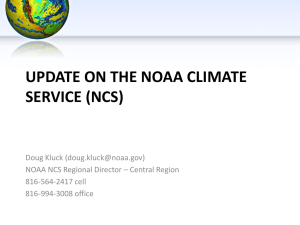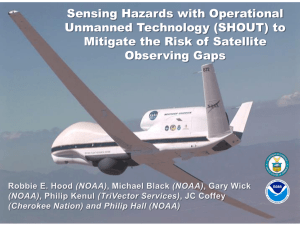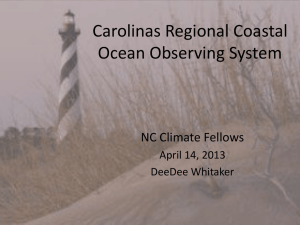NOAA`s Remediation of Underwater Legacy Environmental Threats
advertisement
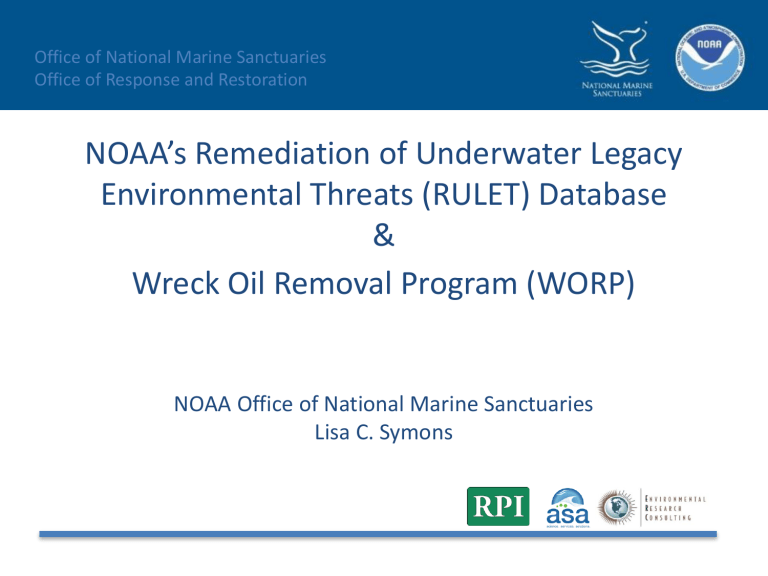
Office of National Marine Sanctuaries Office of Response and Restoration NOAA’s Remediation of Underwater Legacy Environmental Threats (RULET) Database & Wreck Oil Removal Program (WORP) NOAA Office of National Marine Sanctuaries Lisa C. Symons NOAA interests in shipwrecks • Shipwrecks are difficult to categorize but there are several types: – Historic Wrecks – Contemporary Wrecks – Derelict Vessels • Navigation • Pollution • Historic Protection The National Marine Sanctuary System S.S. Jacob Luckenbach Sank on July 14, 1953 off San Francisco. Oil removed in 2003 USS Mississinewa, November, 1944. Sunken in Ulithi Atoll in Federated States of Micronesia. Oil removed in 2003 Resources and Undersea Threats (RUST) Database Cost of Removal Operation per Barrel Removed $100,000,000 More Complex Operation $10,000,000 $1,000,000 $100,000 $10,000 Less Complex Operation $1,000 $100 $10 $1 1 10 100 1,000 Barrels Removed 10,000 100,000 SS Catala January 1, 1965. Abandoned after failed salvage, Ocean Shores, WA, Oil removed in 2006-2007. Leaking Liberty Ship off Sabine Pass, TX Vessel believed to be the SS William Beaumont, sunk 1971. Oil removed 2009. Gasoline Tanker USS Chehalis Sunken 1949 in Pago Pago Harbor, American Samoa. Oil Removed in 2010 M/V Princess Kathleen Grounded and later sank in SE Alaska on Sept. 7, 1952. Oil removed in 2010 RUST Remediation of Underwater Legacy Environmental Threats (RULET)) Initial Narrowing Criteria: 30,000 to 573 • Post 1910 Post 1902 Post 1891 (UK uses 1873) • Steel Hull (as well as iron or concrete) • Tanker/Tank Barge • >200’ or 1000GT RULET: 233 228 162 115 107 High Priority: 58 28 23 Reported to be leaking: 10 0 200 Size or Tonnage Vessels over 1000 gross tons or 200 feet 400 600 RULET Initial Screening: (≈580 Shipwrecks) Over 1,000 gross tons or any tank vessel; Built post 1891; Steel, iron, or concrete hull Removal of coal burning vessels, sailing vessels, or nonhazardous barges; Wrecks outside US EEZ; Vessels that were raised and scrapped; Ships that did not actually sink; Wrecks that NOAA has verified as demolished. (228 Shipwrecks (Aug 2011)) Low to Medium Priority Potential High Priority Very Low Priority Historic Hull Reduction Hull dynamited Wreck not structurally reduced or unknown If known to contain oil still Little vertical relief or structural integrity Current Wreck Condition If no oil is likely Wreck condition is good or unknown Reported to be a jumble of hull plates If known to contain oil still Likelihood of Being Discovered Likely discoverable during dedicated survey Already known or very likely to be discovered If quantity and oil type may necessitate dedicated survey If no survey is warranted As of 1/26/2012 If known to contain oil still If very little oil is likely Vessel Type If no oil is likely Not likely to be discovered (depths > 6,000ft.) If quantity and oil type may necessitate dedicated survey If no survey is warranted Freighter, empty tanker, tank barge, or other Fully laden tanker or tank barge 48 Shipwrecks 23 Shipwrecks 36 Shipwrecks Environmental models predict severe impacts If environmental models predict no impacts or negligible impacts Environmental models predict severe impacts Final Recommendation Monitoring and surveys of opportunity Proactive assessments Overall awareness and surveys of opportunity Was there oil onboard? Pollution Potential Tree (USCG SERT) No Yes or ? Was the wreck demolished? Yes Low Pollution Risk (As of 4/9/12) 15 vessels No or ? Yes Was significant cargo lost during casualty? Yes No or ? No or ? Is cargo area damaged? Likely all cargo lost? Yes Medium Pollution Risk (As of 4/9/12) 80 vessels No or ? High Pollution Risk (As of 4/27/12) 15 vessels Leaking Tanker off Southern Long Island, NY. Believed to be the Coimbra , sunk by U-123 on January 15, 1942 while en route from New York to England with a full cargo of lube oil. Investigation is on-going SS Davy Crockett WWII liberty Ship. Abandoned after failed salvage, Columbia River, WA. Oil removed in 2011 Tanker Montebello, San Luis Obispo, California Loaded with three million gallons of crude oil when it was torpedoed and sunk on December 23, 1941. October 2011, determined to have no significant oil on board. NOAA RULET All US Waters (107) 27 April 2012 Where does this information come from? • Lloyd’s Register of British and Foreign Shipping • Annual List of Merchant Vessels of the United States • National Archives and Records Administration – Records of the U.S. Maritime Commission, 1917-1950 – Records of the U.S. Shipping Board, 1914 – ca. 1939 – Records of the Bureau of Marine Inspection and Navigation – Records of the Office of the Chief of Naval Operations, 1875-2006 – Records of the U.S. Coast Guard, 1785-2005 • Historic Newspapers • United States Coast Guard Incident Investigations • Many other secondary sources (books, internet, databases) ADUS Ltd. highresolution multibeam survey of Lancing. NOAA/UT AUV survey of the Empire Gem, British Splendour (Images courtesy of NOAA) Prioritizing wrecks Resources and Undersea Threats Database Summary Report and follow-up recommendations Modeling trajectory and fate and consequences Initial Screening based on age, size, hull material, type and location Secondary screening based on historical information on vessel, engineering analysis and archaeological site formation Deliverables Overarching Document Provides National Context (similar to IOSC 2005 paper) Vessel Specific Risk Assessments (High & Medium Priority only) - Executive Summary - Vessel Background & Archeological Assessment - Environmental Impact Models - Ecological Resources At Risk - Socio-Economic Resources At Risk - Overall Risk Assessment & Recommendations for Assessment, Monitoring or Remediation Release Scenarios • Release duration of 12 hours • Model simulations run for a 30 days. • Releases assumed to be from a depth between 2 and 3 meters above the sea floor. • Simplified oil types: e.g., South Louisiana light crude (representing crude) and Medium aromatic Fuel Oil No. 2 (representing light fuels). Sunken Tanker Solar 1, Philippines Modeling Assumptions • Applied Science Associates (ASA) Spill Impact Map (SIMAP) • Probabilistic mode • Results based on running model two hundred times using four spill volumes. • Randomly selected environmental information from a longterm wind and current database for the region. SIMAP: Environmental Data Inputs • Winds – Long term observation records (usually 10 years), hourly average speed and direction • • Currents – Long term modeled simulations (usually 10 years), primarily 3dimensional daily average • • Source: NOAA Environmental Sensitivity Index (ESI) Bathymetry – Gridded depth data • • Sources: Global circulation models (e.g. HYCOM), regional hydrodynamic models (e.g. ROMS, HYDROMAP, BFHYDRO) Shoreline Habitats – Gridded habitat types (e.g., sand beach, wetland, rocky shore) • • Source: NOAA NCDC meteorological stations (e.g. coastal and offshore buoys) Sources: General Bathymetric Chart of the Oceans (GEBCO), NOAA NOS Hydrographic Survey, NOAA Coastal Relief Model, NOAA Great Lakes Environmental Research Laboratory (GLERL) Bathymetry Temperature and Salinity – Monthly average vertical profiles • Source: Natural Resource Damage Assessment Model for Coastal and Marine Environments (NRDAM/CME), and Great Lakes Environment (NRDAM/GLE) William Rockefeller: 14,054 gross tons Pollution Potential: in theory 150,000 barrels of Bunker C Vessel Risk Factors A1: Oil Volume (total bbl) Pollution Potential Factors Archaeological Assessment Operational Factors Ecological Risks SocioEconomic Resources Data Quality Score Risk Score Comments High 93,000 barrels, leaking reported in 2011 A2: Oil Type Low The exact type of oil remaining is unknown B: Wreck Clearance High Appears to have been partially cleared C1: Burning of the Ship High Burned prior to sinking C2: Oil on Water Med No oil reported on the water D1: Nature of Casualty High One torpedo D2: Structural Breakup High In two sections, stern yet to be located Archaeological Assessment High Detailed sinking records of this ship exist, assessment is believed to be very accurate Wreck Orientation High Bow inverted, amidships broken up. Depth High 95 feet Visual or Remote Sensing Confirmation of Site Condition High Two sections are well-known recreational dive sites. Other Hazardous Materials Onboard High No Munitions Onboard High No Gravesite (Civilian/Military) High Yes Historical Protection Eligibility (NHPA/SMCA) High NHPA and possibly SMCA Med Not Ranked WORST CASE DISCHARGE 37 High Priority 39 Medium Priority Not Ranked 31 Low Priority WCD Most Probable High Med 3A: Water Column Resources High Large spills of a light fuel oil can have significant impacts to water column resources; smaller spills are less persistent in open water 3B: Water Surface Resources High Large area potentially affected, very high use by marine birds High Med 3C: Shore Resources High Light fuel oiling on sand beaches, not persistent, though seasonally important shorebird habitat Med Low 4A: Water Column Resources High A significant area of water column would be impacted in important fishing grounds High Med 4B: Water Surface Resources High Large offshore water surface area would be impacted in areas with shipping lanes High High 4C: Shore Resources High Moderate length of shoreline with highvalue sensitive resources would be impacted Med Med MOST PROBABLE DISCHARGE (10%) 6 High Priority 36 Medium Priority 65 Low Priority Comparison of Final Scores by Oil Type and Oil Volume Heavy Fuel Crude Oil Light Fuel 18 18 18 16 16 16 14 14 14 12 12 12 10 10 10 8 8 8 6 1,000 10,000 100,000 Barrels 1,000,000 6 1,000 10,000 100,000 Barrels 1,000,000 6 1,000 10,000 100,000 Barrels 1,000,000 NOAA RULET All Wrecks in RRT/EPA Region 2 23 April 2012 NOAA RULET All Wrecks in RRT/EPA Region 3 23 April 2012 NOAA RULET All Wrecks in RRT/EPA Region 4 23 April 2012 NOAA RULET Reportedly Leaking All Districts **USS Arizona Not Depicted** * For Official Use Only * 23 April 2012 Images courtesy of the National Archives Office of National Marine Sanctuaries Office of Response and Restoration Questions? Lisa Symons 301-713-7275 Lisa.Symons@noaa.gov


